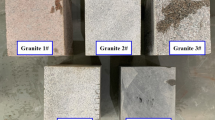Summary
A review of the benefits of assisting mechanical tools, notably drag bits, with moderate pressure waterjets suitably directed with respect to the bit is given. These benefits include reduced bit forces, especially the bit normal force, reduced bit wear, reduced dust make, and reduced incidence of frictional sparking. The research work that has been conducted to date to investigate this phenomenon has been empirical in nature. Experiments are described that extend the data bank of this empirical knowledge. In addition, experiments aimed at gaining a better understanding of the fundamentals of the rock fragmentation process with this hybrid cutting method are outlined.
Results from the first of these experimental series are used to make recommendations as to the position of the jet with respect to the bit, the stand-off distance between the nozzle exit and the bit/rock interface, and the jet energy. In addition, preliminary findings are reported regarding the increase necessary in the jet energy when the bit velocity is increased. Results from the second test series are discussed in the context of rock fracture behaviour induced by mechanical bits acting alone. The likely influence of waterjets on these fracture processes is analysed. It is concluded that, in terms of the bit force reductions, a dominant influence of the jets when used in conjunction with sharp drag bits, is continuous removal of the rock debris that forms ahead of the advancing bit. The observed reductions in bit wear and incidence of frictional sparking are attributed to reduced heat loading of the bit during the cutting operation. Reductions in the dust make are attributed to effective wetting of the fine rock particles before they become entrained in the airstream.
Similar content being viewed by others
References
Anon (1983) Environmental dust surveys of longwall mining operations, inProceedings of the Mini Symposium on Longwall Mining: Research and Development; Safety; Health, Society of Mining Engineers of AIME, 83-COAL-01, Atlanta, Georgia, March, Staff Environmental Assessment and Contaminant Control Branch, MSHA, pp. 113–33.
Barker, J.S., Pomeroy, C.D. and Whittaker, D. (1966) The MRE large pick shearer drum.The Mining Engineer, February, 323–33.
Barton, C.C. (1982) Variables in fracture energy and toughness testing of rock, inProceedings of the 23rd US Symposium on Rock Mechanics, Society of Mining Engineers, University of California, Berkeley, August, pp. 449–62.
Cook, N.G.W. (1982) Wear on drag bits in hard rock, inProceedings of the 14th Canadian Rock Mechanics Symposium, May.
Cook, N.G.W. and Joughin, N.C. (1970) Rock fragmentation by mechanical, chemical and thermal means, inProceedings of the 6th International Mining Congress, Madrid.
Cook, N.G.W., Hood, M. and Tsai, F. (1984) Observations of crack growth in hard rock loaded by an indenter.International Journal of Rock Mechanics and Mining Sciences,21 (2), 97–107.
Dubugnon, O. (1981) An experimental study of water assisted drag bit cutting of rocks, inProceedings of the First US Waterjet Symposium, Golden, Colorado, April, pp. II-4.1–II-4.11.
Friedman, M. (1983) Analysis of rock deformation and fracture induced by rock cutting tools used in coal mining, Sandia Contractor's Report SAND83-7007, March, 39 pp.
Hoagland, R.G., Hahn, G.T. and Rosenfield, A.R. (1973) Influence of microstructure on fracture propagation in rock.Rock Mechanics,5 77–106.
Hood, M. (1976) Cutting strong rock with a drag bit assisted by high pressure water jets.Journal of the South African Institution of Mining and Metallurgy,77 (4), 79–90.
Hood, M. (1978) A study of methods to improve the performance of drag bits used to cut hard rock, PhD thesis, Department of Mining Engineering, University of the Witwatersrand, Republic of South Africa.
Hood, M. and Tutluoglu, L. (1983) Technological advances with waterjet assisted cutting systems, Lawrence Berkeley Laboratory Report to the US Bureau of Mines, October, 72 pp.
Krech, W.W., Henderson, F.A. and Hjelmstad, K.E. (1974) A standard rock suite for rapid excavation research, US Bureau of Mines Report of Investigations No. 7865; 29 pp.
Leach, S.J. and Walker, G.I. (1966) The application of high speed liquid jets to cutting — Some aspects of rock cutting by high speed waterjets, inProceedings of the Royal Society of London,260, 295–308.
Morris, A.H. and Tomlin, M.J. (1984) Experience with boom type roadheaders equipped with high pressure waterjet systems for roadway drivage in UK coal mines. Presented at Industry Meeting on Waterjet Assisted Cutting Sponsored by the US Bureau of Mines, 21 June.
National Coal Board (1982) private communication.
Pimental, I.R.A., Urie, J.T. and Douglas, W.J. (1981) Evaluation of longwall industrial engineering data, Final Technical Report to the US Department of Energy, Contract No. USDOE ET-77-C-01-8915 (11).
Richmond, J.K., Price, G.C., Sapko, M.J. and Kawenski, E.M. (1983) Historical summary of coal mine explosions in the United States, 1959–81, Bureau of Mines Information Circular IC 8909.
Ropchan, D., Wang, F.D. and Wolgamott, J. (1980) Application of waterjet assisted drag bit and pick cutter for the cutting of coal measure rocks, Final Technical Report to the US Department of Energy, Contract No. ET-77-a-01-9082, April.
Roxborough, F.F. (1973) Cutting rocks with picks.The Mining Engineer,132 (153), 445–55.
Schmidt, R.A. (1977) Fracture mechanics of oil shale — Unconfined fracture toughness, stress corrosion cracking and tension test results, inProceedings of the 18th US Symposium on Rock Mechanics, pp. 2A2-1–2A2-6.
Tomlin, M.G. (1982) Field trials with 10000 psi prototype system, inProceedings of Seminar on Waterjet Assisted Roadheaders for Rock Excavation, sponsored by the US Department of Energy and the UK National Coal Board, Pittsburg, Pennsylvania, 26–27 May, pp. C1-C11.
Tutluoglu, L., Hood, M. and Barton, C. (1983) An investigation of the mechanisms of waterjet assistance on the rock cutting process, inProceedings of the 24th Symposium on Rock Mechanics, Society of Petroleum Engineers, State College Texas, 20–22 June, pp. 743–9.
Westwood, A.R.C. (1974) Control and application of environmental sensitive fracture processes, Tewksbury Lecture.Journal of Materials Science,9, 1871–95.
Author information
Authors and Affiliations
Rights and permissions
About this article
Cite this article
Hood, M. Waterjet-assisted rock cutting systems — the present state of the art. International Journal of Mining Engineering 3, 91–111 (1985). https://doi.org/10.1007/BF00881623
Received:
Issue Date:
DOI: https://doi.org/10.1007/BF00881623




